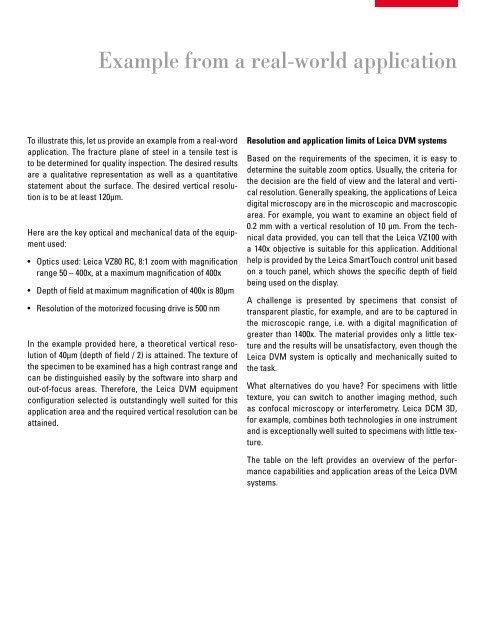Leica DVM - 3D Visualisation
Leica DVM - 3D Visualisation
Leica DVM - 3D Visualisation
Create successful ePaper yourself
Turn your PDF publications into a flip-book with our unique Google optimized e-Paper software.
Example from a real-world application<br />
To illustrate this, let us provide an example from a real-word<br />
application. The fracture plane of steel in a tensile test is<br />
to be determined for quality inspection. The desired results<br />
are a qualitative representation as well as a quantitative<br />
statement about the surface. The desired vertical resolution<br />
is to be at least 120μm.<br />
Here are the key optical and mechanical data of the equipment<br />
used:<br />
• Optics used: <strong>Leica</strong> VZ80 RC, 8:1 zoom with magnification<br />
range 50 – 400x, at a maximum magnification of 400x<br />
• Depth of field at maximum magnification of 400x is 80μm<br />
• Resolution of the motorized focusing drive is 500 nm<br />
In the example provided here, a theoretical vertical resolution<br />
of 40μm (depth of field / 2) is attained. The texture of<br />
the specimen to be examined has a high contrast range and<br />
can be distinguished easily by the software into sharp and<br />
out-of-focus areas. Therefore, the <strong>Leica</strong> <strong>DVM</strong> equipment<br />
configuration selected is outstandingly well suited for this<br />
application area and the required vertical resolution can be<br />
attained.<br />
Resolution and application limits of <strong>Leica</strong> <strong>DVM</strong> systems<br />
Based on the requirements of the specimen, it is easy to<br />
determine the suitable zoom optics. Usually, the criteria for<br />
the decision are the field of view and the lateral and vertical<br />
resolution. Generally speaking, the applications of <strong>Leica</strong><br />
digital microscopy are in the microscopic and macroscopic<br />
area. For example, you want to examine an object field of<br />
0.2 mm with a vertical resolution of 10 μm. From the technical<br />
data provided, you can tell that the <strong>Leica</strong> VZ100 with<br />
a 140x objective is suitable for this application. Additional<br />
help is provided by the <strong>Leica</strong> SmartTouch control unit based<br />
on a touch panel, which shows the specific depth of field<br />
being used on the display.<br />
A challenge is presented by specimens that consist of<br />
transparent plastic, for example, and are to be captured in<br />
the microscopic range, i.e. with a digital magnification of<br />
greater than 1400x. The material provides only a little texture<br />
and the results will be unsatisfactory, even though the<br />
<strong>Leica</strong> <strong>DVM</strong> system is optically and mechanically suited to<br />
the task.<br />
What alternatives do you have? For specimens with little<br />
texture, you can switch to another imaging method, such<br />
as confocal microscopy or interferometry. <strong>Leica</strong> DCM <strong>3D</strong>,<br />
for example, combines both technologies in one instrument<br />
and is exceptionally well suited to specimens with little texture.<br />
The table on the left provides an overview of the performance<br />
capabilities and application areas of the <strong>Leica</strong> <strong>DVM</strong><br />
systems.
















